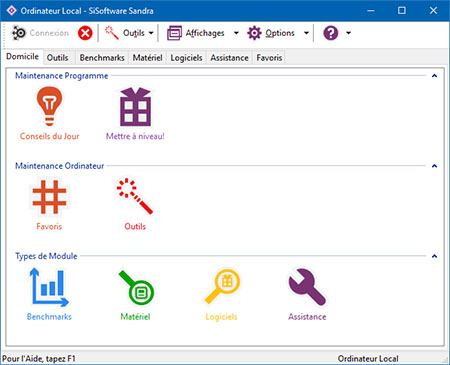Une nouvelle version (30.61) pour le logiciel Sandra 2020

Le programme d’informations SANDRA 2020 vient de sortir dans une nouvelle version estampillée 2020.9.30.61. Il s’agit d’une mise à jour mineure qui apporte plusieurs correctifs au logiciel, notamment en ce qui concerne le support des processeurs.
Sandra 2020 késako ? C’est un petit logiciel qui permet de connaître de nombreux détails techniques à propos de son ordinateur. Il permet aussi de tester plusieurs types de composants afin de connaître les performances de tout ou partie de son PC.
La liste complète des nouveautés est disponible ci-dessous. Et comme d’habitude vous pouvez télécharger Sandra 2020 version 2020.8.30.61 sur cette page de notre section Téléchargement.
MAJ : la version 30.61 remplace la version 30.57 publiée il y a quelques jours. Elle ajoute la prise en charge des processeurs « Tiger Lake » (TGL), un support amélioré des processeurs « Ice Lake » (ICL) et le support de futurs CPU.
Voilà les nouveautés de cette version :
Future Hardware Support
Update R8t adds support for « Tiger Lake » (TGL) as well as updated support for « Ice Lake » (ICL) and future processors.
JCC Erratum Mitigation
Recent Intel processors (SKL ‘Skylake’ and later but not ICL ‘IceLake’) have been found to be impacted by the JCC Erratum that had to be patched through microcode. Naturally this can cause performance degradation depending on benchmark (approx 3% but up to 10%) but can be mitigated through assembler/compiler updates that prevent this issue from happening.
We have updated the tools with with which Sandra is built to mitigate JCC and we have tested the performance implications on both Intel and AMD hardware in the linked articles.
bigLITTLE Hybrid Architecture
While bigLITTLE arch (including low and high-performance asymmetric cores into the same processor) has been used in many ARM processors, Intel is now introducing it to x86 as ‘Foveros’. Thus we have have Atom (low performance but very low power) and Core (high performance but relatively high power) into the same processor – scheduled to run or be ‘parked’ depending on compute demands.
As with any new technology, it will naturally require operating system (scheduler) support and may go through various iterations. Do note that as we’ve discussed in our 2015 (!) article – ARM big.LITTLE: The trouble with heterogeneous multi-processing: when 4 are better than 8 (or when 8 is not always the ‘lucky’ number) – software (including benchmarks) using all cores (big & LITTLE) may have trouble correctly assigning workloads and thus not use such processors optimally.
AMD Power/Performance Determinism
Some AMD’s server processors allow ‘determinism’ to be changed to either ‘performance’ (consistent speed across nodes/sockets) or ‘power’ (consistent power across nodes/sockets). While normally workloads require predictability and thus ‘consistent performance’ – this can be at the expense of speed (not taking advantage of power/thermal headroom for higher speed) and even power (too much power consumed by some sockets/nodes).
Hypervisors
More and more installations are now running in virtualised mode under a (Type 1) Hypervisor: using Hyper-V, Docker, programming tools for various systems (Android, etc.) or even enabling ‘Memory Integrity’ all mean the system will be silently be modified to run in transparently under a hypervisor (Hyper-V on Windows).

Désolé, les commentaires sont fermés.